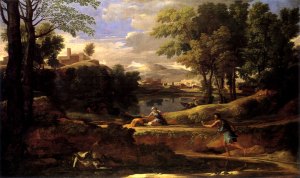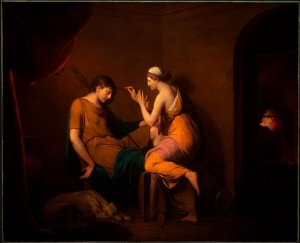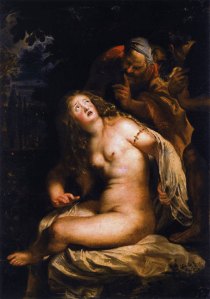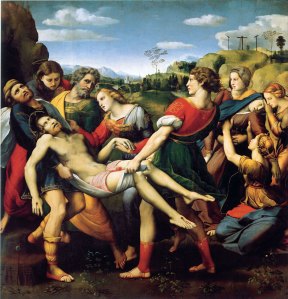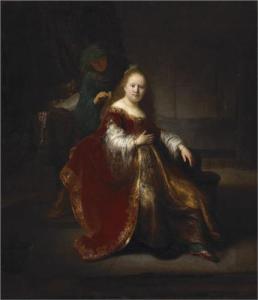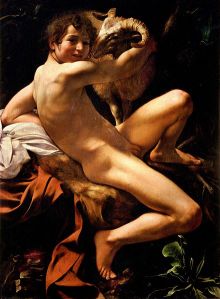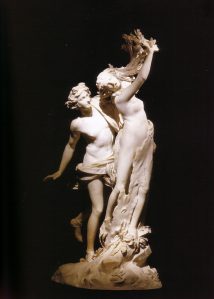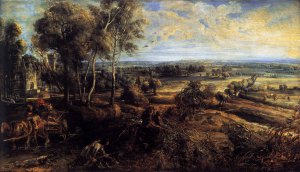
Peter Paul Rubens: 'A View of Het Steen in the Early Morning', 1636. Oil on Oak. Oil on oak.131 x 229.cm. National Gallery, London
http://www.nationalgallery.org.uk/paintings/peter-paul-rubens-a-view-of-het-steen-in-the-early-morning
24th August, morning, not long after opening, summer holidays, no schoolchildren.
The proportions of Het Steen are interesting, much wider than tall, (131.2 x 229.2 cm, ie 1:1.75) a proportion that developed, from the initial central three panels through to the seventeen that he finished with. It is noticeably wider than, for instance the smaller landscape works on the wall behind. A proportion that reinforces the notion that we are not looking through a window, it does not correspond to the windows shown in Het Steen. The painting is not quite two equal squares, they would have to overlap slightly. Certainly the proportions summons up the notion of stereoscopic vision, two eyes not quite combining and the mid point marked at the bottom of the picture plane by the upturned tree.
For someone who made such spectacular paintings of grand horses fighting, the two cart horses really are splendidly rural.
Are there two figures on the tower? Or is just the castellation? The blobs are in roughly the right place for architectural features, but then again they are slightly different colours. The left is bluish, the right is yellow; the blue figure could have an outstretched hand: “This is all mine”. Reading too much into vague sploshes of bravura paint?
If these are figures, than that could place Rubens, the narrator, within the pictorial space at a series of viewpoints. He is on the tower; by the gate; on the cart; as the hunter; as the artist/ creator and of course as the artist/ owner of the estate showing it off to the privileged viewer. And, each time I see this painting I am convinced that this is a view made to be shown rather than an artists’ ‘personal response’ in the late 19th Century manner. The way that our perceptual perambulation is arranged makes that very clear.
Clark talks about Poussin’s tiny figures in ‘The Sight of Death’,
“What are these miniature figures in Poussin about? Why do they come and go in perceptions? Why, once see, do they matter so much?….I think they are best understood as different proposals about recognition and interpretation, about “picking out” what is human in a human and non-human world, about the way humans belong to their surroundings…Let’s talk about stories. They are analogous to the small figures in Poussin: that is, there often turns out to be more and more of them, implied, embedded, the longer one looks.”
(T J Clark: The Sight of Death: An Experiment in Art Writing. Yale University Press, 2006. ISBN 0300137583. Pages 45-50)
The figures then, give the painting agency, do they work the same way in Het Steen?
A young Eastern European (Russian perhaps?) points out the two flying ducks to his girlfriend, then the hunter, then he makes the appropriate internationally recognised gestures for shooting something. She laughs appropriately, but looks slightly embarrassed.
I go to look carefully at the tower, I think that (probably) these are merely battlements/ castellation. Presumably such architectural features were for show. But, whether or not these figures are ‘real’, the point about their role remains. The fisherman on the bridge, or the hint of figures to the left. I return to the bench to find a Japanese woman sitting on my notebook, she is not apologetic.
Thinking about Clark, I go to see Poussin’s ‘Landscape with a Man Killed by a Snake’
http://www.nationalgallery.org.uk/paintings/nicolas-poussin-landscape-with-a-man-killed-by-a-snake
It has been in Room 19 for a while now, but the lighting is bland and dull. Gradually lamps turn on, the room gets brighter and slowly the painting comes to life. It clearly needs strong light, whereas the same lighting scheme kills the Rubens; Het Steen was made for dim candle light: the North. ‘Landscape with a Man Killed by a Snake’ for the bright clear South. Returning to the original position a painting was designed for, can affect how we understand it. Such a search can become an ‘early music’ style fetish, nonetheless it is extraordinary how different art, for example the Poussin here, can look under sympathetic lighting. The lighting clicks off and Landscape’ returns to a dull, dark gloom.
